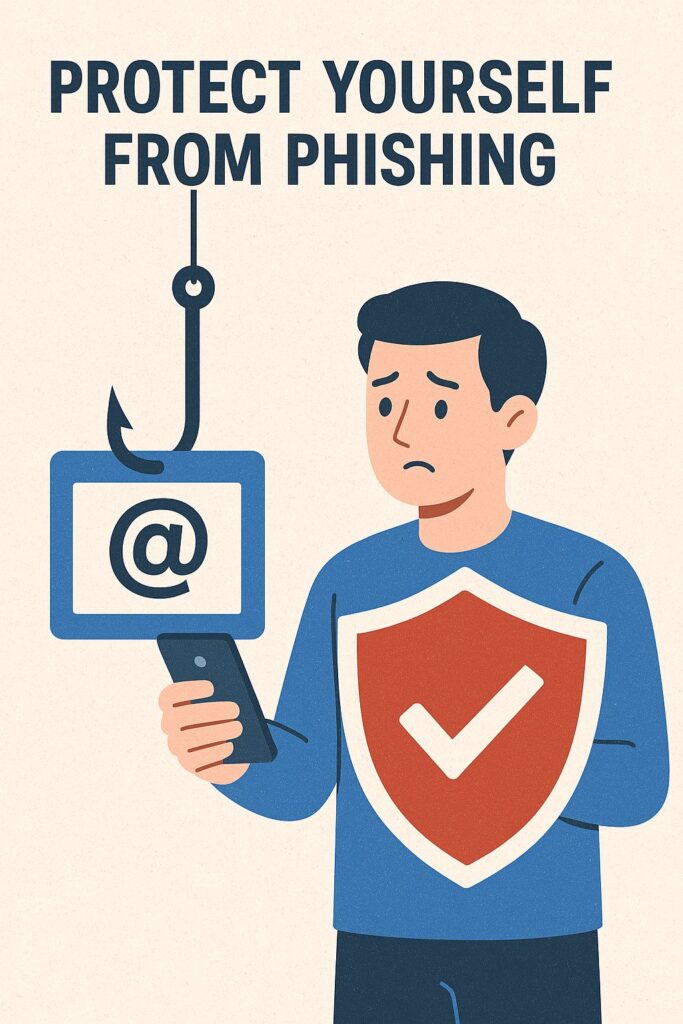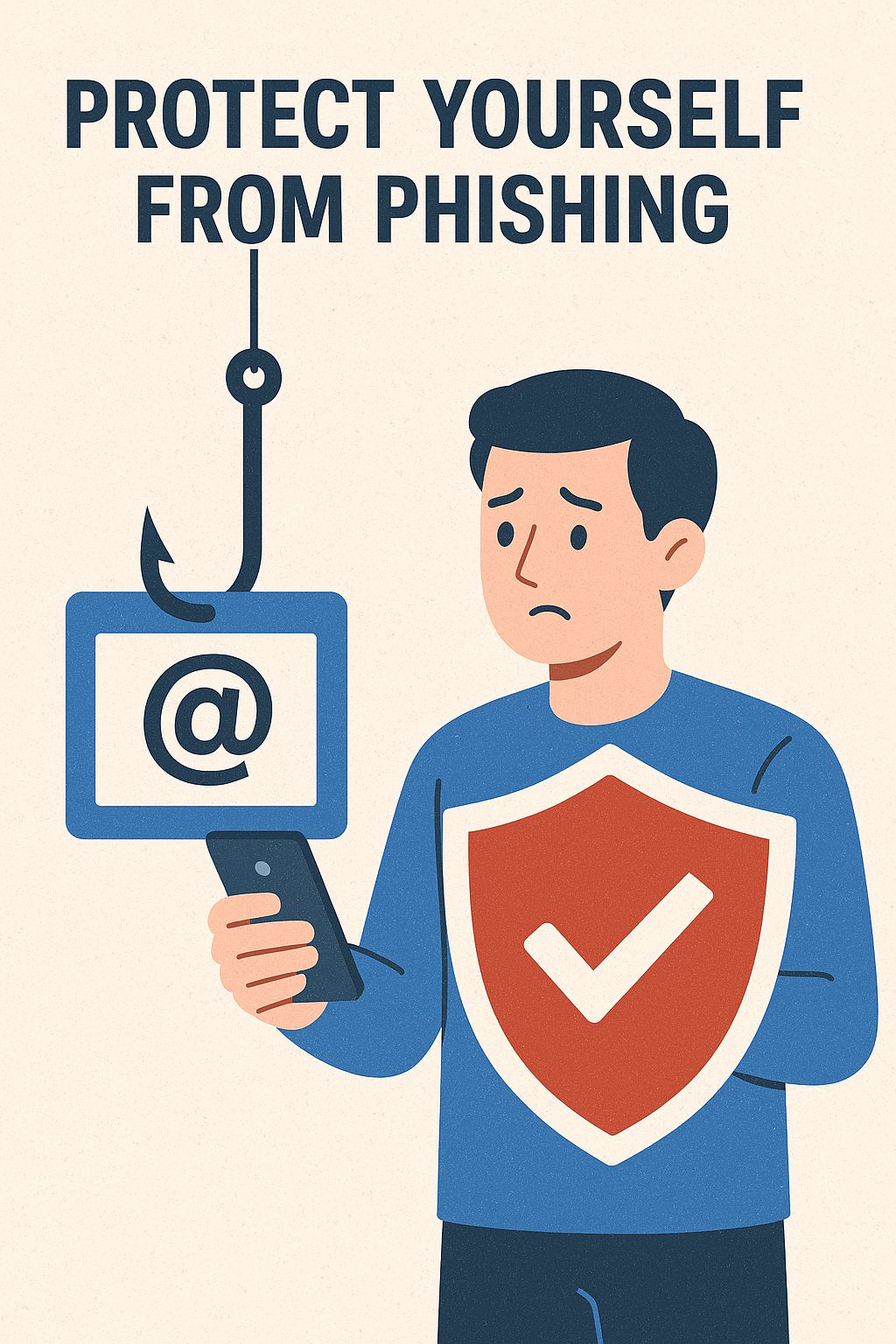Learn how to protect yourself from phishing scams with practical tips. Avoid falling victim to fake emails, fraudulent websites, and online fraud in 2025.
Thank you for reading this post, don't forget to subscribe!Phishing scams are a growing threat in 2025, targeting millions of people across the US, UK, and worldwide. These scams attempt to steal your sensitive information like passwords, credit card numbers, or personal data by pretending to be trusted companies or contacts.
Understanding how phishing works and knowing how to protect yourself is crucial to staying safe online.

What Is Phishing and How Does It Work?
Phishing is a cyberattack that tricks you into revealing personal information. Attackers usually send fake emails, texts, or phone calls that look legitimate. Their goal is to get you to click malicious links, download harmful files, or enter your details on fake websites.
Common signs of phishing include:
- Email addresses or website URLs that look similar but are slightly off (for example, paypal-secure.com instead of paypal.com).
- Messages urging immediate action, like “Verify your account now or it will be suspended.”
- Poor grammar or spelling mistakes in the message.
- Unexpected attachments or links to unfamiliar websites.
How to Protect Yourself from Phishing Attacks
1. Always Verify the Source
Before clicking any link or opening attachments, verify who the message is from. Check the sender’s email carefully, and if anything looks suspicious, don’t trust it.
Instead of clicking links in emails, type the official website address directly into your browser. For example, instead of clicking a link claiming to be from your bank, visit the bank’s website manually.
2. Use Two-Factor Authentication (2FA)
Enable two-factor authentication on your important accounts, including email, banking, and social media. 2FA adds an extra layer of security by requiring a second form of verification, such as a code sent to your phone.
3. Keep Software and Devices Updated
Cybercriminals exploit security weaknesses in outdated software. Regularly update your operating system, browser, and antivirus software to patch these vulnerabilities.
4. Be Careful with Personal Information
Limit how much personal information you share online, especially on social media. Phishers often use details like your birthday or address to make scams more convincing.
5. Use Reliable Security Software
Install trusted antivirus and anti-phishing software that can detect and block malicious websites and emails before they reach you.
What to Do If You Suspect a Phishing Attempt
If you think you’ve been targeted by a phishing scam:
- Do not click any links or download attachments from the suspicious message.
- Change your passwords immediately for affected accounts.
- Contact your bank or credit card provider if you shared financial information.
- Report the phishing attempt to the company impersonated and relevant authorities (like the FTC in the US or Action Fraud in the UK).
- Monitor your accounts regularly for any unauthorized activity.
Final Thoughts
Phishing attacks can be very convincing, but with caution and smart habits, you can protect yourself. Always verify messages, use strong security tools, and stay informed about the latest phishing tactics. These steps will help you avoid falling victim to phishing scams in 2025 and beyond.
1. How can I spot a fake email from my bank?
Look for subtle differences in the sender’s email address, urgent language asking for personal information, spelling mistakes, and suspicious links. Always verify by contacting your bank directly through official channels.
2. What are common signs of phishing emails?
Phishing emails often have misspelled words, unfamiliar sender addresses, urgent requests, and links that lead to fake websites. They may also contain unexpected attachments.
3. What should I do if I think I have been phished?
Immediately change your passwords, especially for your email and banking accounts. Contact your bank if financial information was shared and report the incident to relevant authorities.
4. How does two-factor authentication help prevent phishing attacks?
Two-factor authentication adds a second layer of security by requiring a code from your phone or an app, so even if your password is stolen, attackers cannot access your account.
5. What is the best antivirus software for phishing protection?
Look for antivirus programs with real-time scanning and anti-phishing features, such as Norton, Bitdefender, or Kaspersky. Make sure it updates regularly to detect new threats.
6. How can small businesses protect themselves from phishing scams?
Train employees to recognize phishing attempts, use two-factor authentication, keep software updated, and implement strong email filters to block suspicious messages.
7. Are phishing attacks common in the US and UK?
Yes, phishing attacks are widespread in both countries, targeting individuals and businesses alike. Staying informed and cautious is essential to avoid falling victim.
8. What browser settings can help me avoid phishing websites?
Enable safe browsing features, keep your browser updated, disable automatic downloads, and consider using browser extensions that block malicious sites.
9. How do phishing attacks work and how can I avoid them?
Phishing attacks trick you into giving away personal info via fake emails or websites. Avoid them by verifying senders, not clicking suspicious links, and using security tools like antivirus and 2FA.
10. What steps should I take to secure my online accounts after a phishing attack?
Change your passwords immediately, enable two-factor authentication, review account activity for unauthorized access, and alert your service providers.
